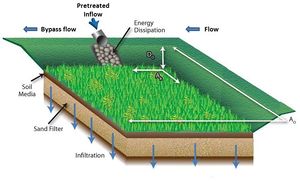
Difference between revisions of "Stormwater infiltration"
m |
|||
| Line 24: | Line 24: | ||
**[[Stormwater infiltration and contaminated soils and groundwater|Contaminated soils and groundwater]] | **[[Stormwater infiltration and contaminated soils and groundwater|Contaminated soils and groundwater]] | ||
**[http://stormwater.pca.state.mn.us/index.php/Procedures_for_investigating_sites_with_potential_constraints_on_stormwater_infiltration Procedures for investigating sites with potential constraints] | **[http://stormwater.pca.state.mn.us/index.php/Procedures_for_investigating_sites_with_potential_constraints_on_stormwater_infiltration Procedures for investigating sites with potential constraints] | ||
| + | **[[Guidance for amending soils with rapid or high infiltration rates]] | ||
*[[Decision tools for stormwater infiltration|Decision tools]] | *[[Decision tools for stormwater infiltration|Decision tools]] | ||
| − | |||
<!--*[[Stormwater infiltration research needs|Research needs]]--> | <!--*[[Stormwater infiltration research needs|Research needs]]--> | ||
*Determining soil infiltration | *Determining soil infiltration | ||
Revision as of 17:43, 31 July 2018

Schematic showing an infiltration basin, which is one of several stormwater control practices designed to infiltrate stormwater runoff. Infiltration practices capture stormwater runoff and allow it to infiltrate into the underlying soil. Pollutant removal occurs through a variety of mechanisms, including adsorption, absorption, plant uptake, and degradation. Note that inflow into the practice has undergone pretreatment and that once the practice is filled, runoff bypasses the practice rather than entering it.
This page contains links to several pages that address infiltration of stormwater runoff. Link to portal for Infiltration Practices.
- Overview
- Pre-treatment considerations for stormwater infiltration
- Best Management Practices (BMPs)
- Water quality
- Water quantity
- Separation distances
- Constraints
- When infiltration is not authorized under a stormwater permit
- Karst
- Shallow soils and shallow depth to bedrock
- Shallow groundwater
- Soils with low infiltration capacity
- Potential stormwater hotspots
- Wellhead protection
- Contaminated soils and groundwater
- Procedures for investigating sites with potential constraints
- Guidance for amending soils with rapid or high infiltration rates
- Decision tools
- Determining soil infiltration
- References for stormwater infiltration
- Supporting material for infiltration